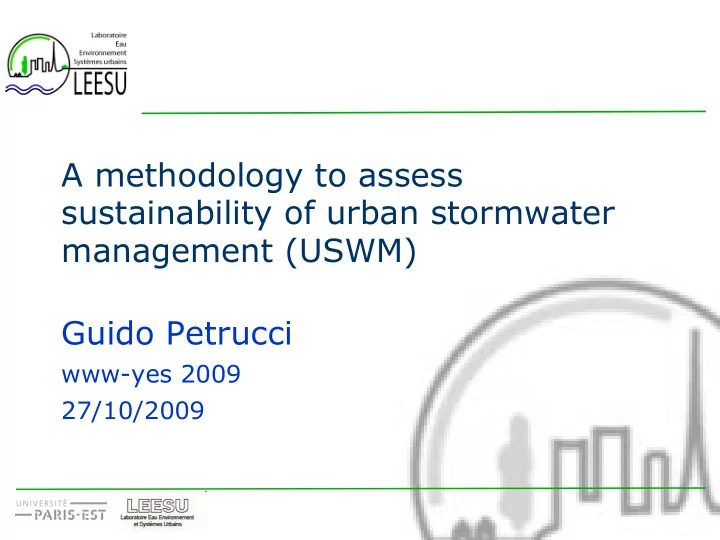

A methodology to assess sustainability of urban stormwater management (USWM) Guido Petrucci www-yes 2009 27/10/2009
Plan Context Issues Methodology Conclusions
From sewers to source control Why? • Water quality concerns • Urban growth But, what is “better” to do? • Do sewer and source control be alternative or complementary? Where? In which conditions? • Which is the good management level? We need a tool to assess overall “sustainability” of USWM
Sustainability assessment: issues • Local dependency on context • Variety of alternatives • Complexity of physical phenomena • Non-technical complexity • Behaviour evolution over time (in general: not enough feedbacks)
Sustainability assessment: proposed methodology 1. A general framework to define We are sustainability here! Physical Urban USWM 2. Case studies contexts contexts strategies + + 3. Generalization Alternatives to compare Criterion Criterion Sub-criterion 1 Sub-criterion 1 Indicator 1 Indicator 1 1 1 Criteria Sub-criteria Indicators Sub-criterion 2 Sub-criterion 2 Indicator 2 Indicator 2 Design storm return interval storage volume (m3/ha) … … … … … … Response rate for superimposed critical storm durations Storage and flood control (m3/ha/hr) Indicator i Indicator i Ratio of storage to contributing drainage area (ratio) Flood Control Number of floods per year within catchment (1...n) Criterion Criterion Sub-criterion n Sub-criterion n … … Overflow frequency and duration (1...n) m m Indicator p Indicator p Discharge or throttle rate (m3/s) Uniform flow distribution (H/M/L) Length of antecedent dry periods () Pollutant concentration probability exceedance for given Water quality treatment target levels (% exceedance for given target level) Pollution Control First-flush capture potential (10/15mm effective runoff treatment for all storms) (mm runoff/av storm event) Technical %age pollution capture for given RI storms and retention times (% capture for given RI or retention time) Design freeboard for storage and water quality change System flexibility & potential Capability for change over (%; m3/lifetime) Ease of retrofitting and modification (H/M/L) for retrofitting Costs of retrofitting and add-on structures/features (Euro time (av.cost)) Potential to recycle system components/waste (H/M/L) Reliability (H/M/L) Durability (H/M/L) Integration Impact on drainage existing system Flow reduction to STP and CSOs (%; m3) with system Reduction in stormwater flows (%; m3/ha) Design Operational lifetime (Years) life Sedimentation rates and storage volume (m3/yr; % reduction in storage volume/yr)
Methodology (1/3): A framework for sustainability Criteria (general, 6) ... Indicators (local, 65) • From DSS: an Criteria Sub-criteria Indicators objective approach to Design storm return interval storage volume (m3/ha) Response rate for superimposed critical storm durations sustainability Storage and flood control (m3/ha/hr) Ratio of storage to contributing drainage area (ratio) Flood Control Number of floods per year within catchment (1...n) • A general to local Overflow frequency and duration (1...n) Discharge or throttle rate (m3/s) approach: the Uniform flow distribution (H/M/L) Length of antecedent dry periods () Christmas tree Pollutant concentration probability exceedance for given Water quality treatment target levels (% exceedance for given target level) Pollution Control First-flush capture potential (10/15mm effective runoff treatment for all storms) (mm runoff/av storm event) Technical %age pollution capture for given RI storms and retention times (% capture for given RI or retention time) Design freeboard for storage and water quality change ystem flexibility & potential • Test the framework by yourself: « if apability for change over (%; m3/lifetime) Ease of retrofitting and modification (H/M/L) one system is better than another for for retrofitting Costs of retrofitting and add-on structures/features (Euro all the indicators, is it more time (av.cost)) Potential to recycle system components/waste (H/M/L) sustainable? » (The entire list is Reliability (H/M/L) available on: www.daywater.cz) ...…
Methodology (2/3): Case studies Three objectives : – Validate framework – Find models and procedures to estimate indicators – Support the generalization phase – Answer to: “what happens, in reality?”
Methodology (3/3): Generalization • Crossing of: – Definitions of sustainability – Urban contexts Physical Urban USWM contexts contexts strategies – Physical contexts + + – USWM strategies Alternatives to compare And then run models & compare Criterion Criterion Sub-criterion 1 Sub-criterion 1 Indicator 1 Indicator 1 1 1 Sub-criterion 2 Sub-criterion 2 Indicator 2 Indicator 2 … … … … … … • How to select? Indicator i Indicator i Criterion Criterion Sub-criterion n Sub-criterion n … … m m Indicator p Indicator p
Conclusions & discussion Issues: In our methodology: • Local dependency on context √ Tree structures • Variety of alternatives √ Combination system • Complexity of physical ? Depends on models phenomena • Non-technical complexity ? Depends on case studies • Behaviour evolution over time X we have to wait further (in general: not enough studies, uncertainties in feedbacks) scenarios We are still nel mezzo del cammin... … and the methodology needs fine tuning ... … but it solves some issues! What do you think about that?
Recommend
More recommend